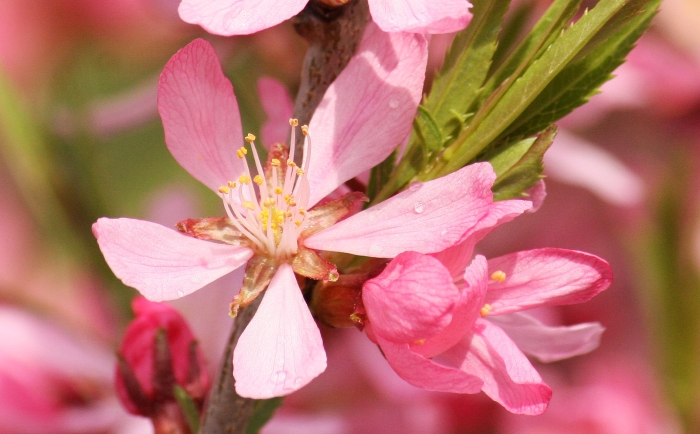Dwarf Russian Almond
(Prunus tenella)
Dwarf Russian Almond (Prunus tenella)
/
/

Maja Dumat
CC BY 2.0
Image By:
Maja Dumat
Recorded By:
Copyright:
CC BY 2.0
Copyright Notice:
Photo by: Maja Dumat | License Type: CC BY 2.0 | License URL: https://creativecommons.org/licenses/by-sa/2.0/ | Uploader: blumenbiene | Publisher: Flickr |


















































Estimated Native Range
Summary
Prunus tenella, commonly known as Dwarf Russian Almond, is a deciduous shrub native to steppes and hillsides in Southeastern Europe and Western Asia. It typically grows to a height of 1.5 meters (5 feet) and is known for its compact size and rounded shape. The Dwarf Russian Almond produces showy pink flowers in early spring, often before the leaves appear, creating a striking display against the bare branches. The flowers are followed by small, hairy fruits that resemble miniature almonds and have a characteristic flavor, though they are not widely cultivated for consumption.
The Dwarf Russian Almond is valued for its ornamental qualities, including its profuse spring blossom and exceptional winter hardiness, making it a popular choice for cold temperate regions. It is commonly used in border plantings, rock gardens, and as a low hedge. This shrub is easy to maintain and can tolerate a range of soil types, from well-drained sandy soils to heavier clays, as long as they are not waterlogged. It prefers full sun but can also grow in part shade. While generally disease-resistant, it can be susceptible to leaf spot and canker diseases. Pruning after flowering helps maintain its shape and encourages healthy growth.CC BY-SA 4.0
The Dwarf Russian Almond is valued for its ornamental qualities, including its profuse spring blossom and exceptional winter hardiness, making it a popular choice for cold temperate regions. It is commonly used in border plantings, rock gardens, and as a low hedge. This shrub is easy to maintain and can tolerate a range of soil types, from well-drained sandy soils to heavier clays, as long as they are not waterlogged. It prefers full sun but can also grow in part shade. While generally disease-resistant, it can be susceptible to leaf spot and canker diseases. Pruning after flowering helps maintain its shape and encourages healthy growth.CC BY-SA 4.0
Plant Description
- Plant Type: Shrub
- Height: 4-4 feet
- Width: 3-2 feet
- Growth Rate: Moderate
- Flower Color: Pink
- Flowering Season: Spring
- Leaf Retention: Deciduous
Growth Requirements
- Sun: Full Sun
- Water: Medium
- Drainage: Medium
Common Uses
Bee Garden, Bird Garden, Butterfly Garden, Edible*Disclaimer: Easyscape's listed plant edibility is for informational use. Always verify the safety and proper identification of any plant before consumption., Fragrant, Low Maintenance, Rabbit Resistant, Showy Flowers
Natural Habitat
Steppes and hillsides in Southeastern Europe and Western Asia
Other Names
Common Names: Russian Almond, Zwerg-Mandel, Zwergmandel, Amandier Nain, Dvärgmandel, Prunus, Ai Bian Tao
Scientific Names: , Prunus tenella, Amygdalus nana, Amygdalus ledebouriana, Prunus ledebouriana, Amygdalus georgica, Prunus tenella f. gessleriana, Prunus tenella f. alba, Amygdalus gessleriana, Persica nana
GBIF Accepted Name: Prunus tenella Batsch